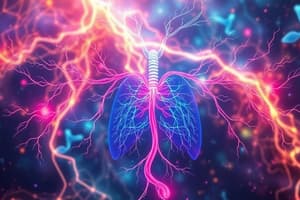Podcast
Questions and Answers
Name three substances secreted by exocrine glands.
Name three substances secreted by exocrine glands.
Sweat, saliva, and mucus.
Describe how endocrine glands release hormones.
Describe how endocrine glands release hormones.
Endocrine glands secrete hormones directly into the blood.
What are target tissues in the context of hormone action?
What are target tissues in the context of hormone action?
Target tissues are specific tissues that recognize and are affected by a particular hormone.
List two factors that can affect hormone production and function.
List two factors that can affect hormone production and function.
What is meant by the 'antagonistic action' of certain hormones?
What is meant by the 'antagonistic action' of certain hormones?
What is a major difference between steroid and non-steroid hormones regarding their ability to cross cell membranes?
What is a major difference between steroid and non-steroid hormones regarding their ability to cross cell membranes?
What is the role of the hypothalamus in the endocrine system?
What is the role of the hypothalamus in the endocrine system?
Why is the pituitary gland sometimes referred to as the 'master gland'?
Why is the pituitary gland sometimes referred to as the 'master gland'?
What is the primary function of the endocrine system in the body?
What is the primary function of the endocrine system in the body?
Define the term 'homeostasis' in the context of biological systems.
Define the term 'homeostasis' in the context of biological systems.
Name three specific physiological parameters that need to be kept within certain limits in the body to maintain homeostasis.
Name three specific physiological parameters that need to be kept within certain limits in the body to maintain homeostasis.
What are the two main mechanisms the body uses to return to normal limits during disruptions in homeostasis?
What are the two main mechanisms the body uses to return to normal limits during disruptions in homeostasis?
How does the endocrine system transmit messages throughout the body?
How does the endocrine system transmit messages throughout the body?
Contrast the speed of response and duration of effects between the nervous and endocrine system.
Contrast the speed of response and duration of effects between the nervous and endocrine system.
What are hormones, and what is their primary role in the body?
What are hormones, and what is their primary role in the body?
Describe how exocrine glands differ from endocrine glands.
Describe how exocrine glands differ from endocrine glands.
What stimulates the pancreas to release insulin?
What stimulates the pancreas to release insulin?
How does the liver respond after insulin is released?
How does the liver respond after insulin is released?
What happens to blood glucose levels after insulin is released?
What happens to blood glucose levels after insulin is released?
What triggers the pancreas to release glucagon?
What triggers the pancreas to release glucagon?
Describe the role of glucagon in regulating blood sugar.
Describe the role of glucagon in regulating blood sugar.
What hormone is responsible for the development of female secondary sexual characteristics?
What hormone is responsible for the development of female secondary sexual characteristics?
What role do pituitary hormones play in the endocrine system?
What role do pituitary hormones play in the endocrine system?
How does testosterone affect male reproduction?
How does testosterone affect male reproduction?
What is one effect of hormonal influence on biorhythms mentioned in the content?
What is one effect of hormonal influence on biorhythms mentioned in the content?
Name two hormones produced by the anterior lobe of the pituitary gland and their functions.
Name two hormones produced by the anterior lobe of the pituitary gland and their functions.
How does the posterior lobe of the pituitary gland differ from the anterior lobe?
How does the posterior lobe of the pituitary gland differ from the anterior lobe?
What is the function of calcitonin produced by the thyroid gland?
What is the function of calcitonin produced by the thyroid gland?
What are the two sections of the adrenal gland and their primary functions?
What are the two sections of the adrenal gland and their primary functions?
What triggers the secretion of insulin and glucagon from the pancreas?
What triggers the secretion of insulin and glucagon from the pancreas?
Which hormone stimulates milk production in females?
Which hormone stimulates milk production in females?
Describe the role of oxytocin in the female reproductive system.
Describe the role of oxytocin in the female reproductive system.
Flashcards
What is homeostasis?
What is homeostasis?
Maintain a constant internal environment in the body despite changes in the surroundings.
What is the Endocrine System?
What is the Endocrine System?
A group of tissues and organs that release hormones to control body processes.
What are hormones?
What are hormones?
Chemical messengers produced by the endocrine system that travel through the blood to target cells.
What are endocrine glands?
What are endocrine glands?
Signup and view all the flashcards
Name some key endocrine glands.
Name some key endocrine glands.
Signup and view all the flashcards
What are exocrine glands?
What are exocrine glands?
Signup and view all the flashcards
What are duct glands?
What are duct glands?
Signup and view all the flashcards
What are ductless glands?
What are ductless glands?
Signup and view all the flashcards
Exocrine glands
Exocrine glands
Signup and view all the flashcards
Endocrine glands
Endocrine glands
Signup and view all the flashcards
Hormones
Hormones
Signup and view all the flashcards
Factors affecting hormone production and function
Factors affecting hormone production and function
Signup and view all the flashcards
Hormone actions
Hormone actions
Signup and view all the flashcards
Antagonistic hormones
Antagonistic hormones
Signup and view all the flashcards
Steroid hormones
Steroid hormones
Signup and view all the flashcards
Non-steroid hormones
Non-steroid hormones
Signup and view all the flashcards
Stimulating Hormones
Stimulating Hormones
Signup and view all the flashcards
Anterior Pituitary
Anterior Pituitary
Signup and view all the flashcards
What does TSH stand for?
What does TSH stand for?
Signup and view all the flashcards
FSH and LH
FSH and LH
Signup and view all the flashcards
What is GH?
What is GH?
Signup and view all the flashcards
What does ACTH do?
What does ACTH do?
Signup and view all the flashcards
What is the function of PRL?
What is the function of PRL?
Signup and view all the flashcards
Posterior Pituitary
Posterior Pituitary
Signup and view all the flashcards
How does insulin regulate blood glucose?
How does insulin regulate blood glucose?
Signup and view all the flashcards
How does glucagon regulate blood glucose?
How does glucagon regulate blood glucose?
Signup and view all the flashcards
What are the functions of testosterone?
What are the functions of testosterone?
Signup and view all the flashcards
What are the functions of estrogen?
What are the functions of estrogen?
Signup and view all the flashcards
What is the function of progesterone?
What is the function of progesterone?
Signup and view all the flashcards
What is the function of melatonin?
What is the function of melatonin?
Signup and view all the flashcards
What are hormones and what do they do?
What are hormones and what do they do?
Signup and view all the flashcards
Study Notes
Endocrine System Overview
- The endocrine system is a system of glands and tissues that produce hormones within the body
- Hormones are chemicals circulating in the blood. Regulate organs and tissues
- The endocrine and nervous system work most importantly together to maintain homeostasis
Homeostasis
- A process of maintaining a constant internal environment during external changes
- Internal state remains consistent regardless of outside factors
- Factors such as body temperature, blood pressure and blood pH need to remain in certain healthy ranges
Types of Glands
- Endocrine glands secrete hormones directly into the bloodstream.
- Hormones move through the blood stream to reach target tissues
- Exocrine glands secrete hormones into ducts
- Examples of exocrine hormones: sweat, saliva, mucus
Hormones
- Chemical substance released from a cell or gland
- Carry messages throughout the body affecting cells and organs
- Specific target tissues recognize each type of hormone
Hormone Production Factors
- Hormone amount released
- Bloodflow in target organs/tissues
- Hormone half-life (time it takes to work)
- Health issues (disease, injury)
Hormone Actions
- Stimulate target tissue and increase activity
- Inhibit target tissue and decrease activity
- Trigger actions in cells - speed-up, slow down, start/stop reactions
- Antagonistic action: Hormones work against each other to maintain homeostasis
- Ex: blood sugar levels
Types of Hormones
- Steroid hormones - made up of cholesterol, fat-soluble, can cross cell membranes directly
- Non-steroid hormones - made up of proteins and amino acids, not fat-soluble, require receptors to enter cells
Important Glands and their Functions
1. Hypothalamus
- Master control center of the endocrine system
- Important link between nervous and endocrine systems
- Produces releasing hormones that stimulate other endocrine hormone production
- Controls pituitary gland secretions
2. Pituitary Gland (Hypophysis)
- "Master gland", controls other endocrine glands
- Pituitary hormones stimulate other endocrine glands to produce their own hormones
- Anterior lobe (controlled by hypothalamus): produces TSH, FSH, LH, GH, ACTH, PRL
- Posterior lobe (stores and releases hypothalamic hormones): produces oxytocin, ADH
3. Thyroid Gland
- Influences cellular metabolic rate
- Produces thyroxine; regulates heart rates, digestive organs, brain development, muscle control
- Produces calcitonin; regulates blood calcium levels
4. Parathyroid Glands
- Located in the thyroid gland
- Regulates blood calcium levels
5. Adrenal Glands
- Located above the kidneys
- Divided into cortex and medulla
- Adrenal medulla produces adrenaline and noradrenaline (fight or flight response)
6. Pancreas
- Produces hormones to regulate blood sugar levels
- Insulin reduces blood sugar when levels are high
- Glucagon increases blood sugar when levels are low
7. Testicles
- Produce testosterone
- Develop secondary sexual characteristics, promote sperm production
8. Ovaries
- Produce estrogen and progesterone
- Estrogen develops characteristics and prepares the uterus for pregnancy
- Progesterone maintains the uterus during pregnancy
9. Pineal Gland (Epithalamus)
- Affects sexual development and biorhythms
- Produces melatonin; regulates sleep/wake cycles, mood and seasonal responses
10. Thymus Gland
- Part of the immune system
- Lymphocytes (T cells) mature within the thymus gland
- Disappears after late puberty; spleen continues to produce T cells
Studying That Suits You
Use AI to generate personalized quizzes and flashcards to suit your learning preferences.




